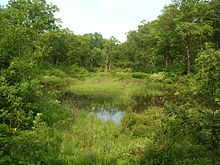- Interdunal wetland
-
 An interdunal wetland in wooded dunes, at Miller Woods in the Indiana Dunes National Lakeshore.
An interdunal wetland in wooded dunes, at Miller Woods in the Indiana Dunes National Lakeshore.
An interdunal wetland or interdunal pond is a water-filled depression between coastal sand dunes. It may be formed either by wind erosion or by dunal encroachment on an existing wetland.[1] The wind erosion process involves wind scooping out sufficient sand to reach the water table, and typically occurs behind the first line of foredunes.[2]
Because they are typically very shallow, interdunal wetlands warm quickly, and provide an abundant source of invertebrates eaten by many species of shorebirds.[3] Many interdunal wetlands are ephemeral, drying out during periods of low rain or low water.
In the Great Lakes region of North America, interdunal communities are typically mildly calcareous and dominated by rushes, sedges and shrubs.[3] They are tentatively classified as G2, or globally imperiled, under the NatureServe rankings.[1][3]
A distinction is sometimes made between interdunal and intradunal wetlands such as pannes, which form within a single dune as part of a a blowout.
References
- ^ a b Wisconsin Department of Natural Resources (2008-10-13). "Interdunal Wetland". Natural Communities of Wisconsin. http://dnr.wi.gov/org/land/er/communities/index.asp?mode=detail&Code=CPHER068WI. Retrieved 2011-06-26.
- ^ Washington Department of Natural Resources. "Ecological Integrity Assessment: North Pacific Coastal Interdunal Wetland". http://www1.dnr.wa.gov/nhp/refdesk/communities/pdf/eia/np_interdunal_wetland.pdf. Retrieved 2011-06-26.
- ^ a b c Kost, M.A.; Albert, D.A.; Cohen, J.G.; Slaughter, B.S.; Schillo, R.K.; Weber, C.R.; Chapman, K.A. (2007). "Interdunal Wetland". Natural Communities of Michigan: Classification and Description. http://web4.msue.msu.edu/mnfi/communities/community.cfm?id=10668.
Categories:- Wetlands
- Dunes
Wikimedia Foundation. 2010.
